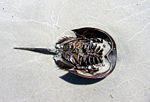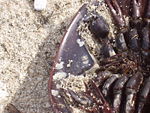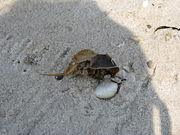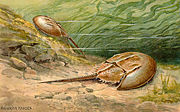Horseshoe crab
| Horseshoe crab | ||||||||||||||||
|---|---|---|---|---|---|---|---|---|---|---|---|---|---|---|---|---|
 Limulus polyphemus from many angles
|
||||||||||||||||
| Conservation status | ||||||||||||||||
| Scientific classification | ||||||||||||||||
|
||||||||||||||||
| Binomial name | ||||||||||||||||
| Limulus polyphemus Linnaeus, 1758 |
The horseshoe crab or Atlantic horseshoe crab (Limulus polyphemus) is a marine chelicerate arthropod. Despite its name, it is more closely related to spiders, ticks, and scorpions than to crabs.[3] Horseshoe crabs are most commonly found in the Gulf of Mexico and along the northern Atlantic coast of North America. A main area of annual migration is the Delaware Bay, although stray individuals are occasionally found in Europe.[4]
The other three species in the family Limulidae are also called horseshoe crabs.[5] The Japanese horseshoe crab (Tachypleus tridentatus) is found in the Seto Inland Sea, and is considered an endangered species because of loss of habitat. Two other species occur along the east coast of India: Tachypleus gigas and Carcinoscorpius rotundicauda.[6] All four are quite similar in form and behavior.
The extinct diminutive horseshoe crab, Lunataspis aurora, 4 centimetres (1.6 in) from head to tail-tip, has been identified in 445-million-year-old Ordovician strata in Manitoba.[7]
Contents |
Names
This group of animals is also known as horsefoot, king crab, or saucepan. Some people call the horseshoe crab a "helmet crab", but this common name is more frequently applied to a true crab, a malacostracan, of the species Telmessus cheiragonus. King crab is also more usually applied to a group of decapod crustaceans.
Limulus means "odd"[8] and polyphemus refers to the giant in greek mythology.[9] It is based on the misleading idea that the animal had a single eye.
Former scientific names include Limulus cyclops, Xiphosura americana and Polyphemus occidentalis.
Shell description
| seashells |
|---|
 |
| mollusk shells |
| snail shells |
| clam shells |
| mother of pearl |
| tusk shells |
| chitons |
|
|
| crustacean shells |
| horseshoe crabs |
| echinoderm tests |
| brachiopod shells |
|
|
| exoskeleton |
| conchology |

In areas where Limulus is common, the shells, exoskeletons or exuviae (molted shells) of horseshoe crabs frequently wash up on beaches, either as whole shells, or as disarticulated pieces.
The shell of these animals consists of three parts. The carapace is the smooth frontmost part of the crab which contains the eyes (five pairs), one pair of small pincers/chelicerae used to move food towards the mouth, five pairs of walking legs (the first four with claws, the last with a leaflike structure used for pushing)[10], the mouth in between the legs, the brain, and the heart. The abdomen is the middle portion where the gills are attached as well as the genital operculum. The last section is the telson (i.e., tail or caudal spine) which is used to steer in the water and also to flip itself over if stuck upside down.
The horseshoe crab can grow up to 60 centimetres (24 in) in length (including tail); the female is typically 25 to 30 percent larger than the male.[11]
Anatomy and physiology


Horseshoe crabs possess five pairs of book gills, located just behind their appendages, that allow them to breathe underwater, and can also allow them to breathe on land for short periods of time, provided the gills remain moist.
Although most arthropods have mandibles, the horseshoe crab is jawless. The mouth is located in the middle of the underside of the cephalothorax, with chelicerae located at each side of the mouth. In the female, the four large legs are all alike, and end in pincers. In the male, the first of the four large legs is modified, with a bulbous claw that serves to lock the male to the female while she deposits the eggs and he waits to fertilize them.
Limulus has been extensively used in research into the physiology of vision. It has four compound eyes, and each ommatidium feeds into a single nerve fibre. Furthermore the nerves are large and relatively accessible. This made it possible for electrophysiologists to record the nervous response to light stimulation easily, and to observe visual phenomena like lateral inhibition working at the cellular level. More recently, behavioral experiments have investigated the functions of visual perception in Limulus. Habituation and classical conditioning to light stimuli have been demonstrated, as has the use of brightness and shape information by males when recognizing potential mates.
Limulus has two large compound eyes on the sides of its head, which have monochromatic vision.[note 1][12] The individual ommatidia are complex, consisting of upwards of 300 cells;[13] they number around a thousand,[13] and are somewhat messily arranged, not falling into the ordered hexagonal pattern seen in more derived arthropods.[12] An additional simple eye is positioned at the rear of each of these structures.[12] In addition to these obvious structures, it also has two smaller ocelli situated in the middle-front of its carapace, which may superficially be mistaken for nostrils.[12] A further simple eye is located beneath these, on the underside of the carapace.[12] A further pair of simple eyes are positioned just in front of the mouth.[12] The simple eyes are probably important during the embryonic or larval stages of the organism,[12] and even unhatched embryos seem to be able to sense light levels from within their buried eggs.[13] The less sensitive compound eyes, and the median ocelli, become the dominant sight organisms during adulthood.[12]
The individual ommatidia of the compound eyes of Limulus Among other senses, they have a small sense organ which senses on the triangular area formed by the exoskeleton beneath the body near the ventral eyes.

Life cycle and behaviour

Before becoming mature around age 9, they have to shed their shells some 17 times.[11] They can live for as long as 31 years.
The crabs feed on mollusks, annelid worms, other benthic invertebrates, and bits of fish. Lacking jaws, it grinds up the food with bristles on its legs and a gizzard that contains sand and gravel.[11]
They spend the winters on the continental shelf and emerge at the shoreline in late spring to spawn, with the males arriving first. The smaller male grabs on to the back of a female with a "boxing glove" like structure on his front claws, often holding on for months at a time. After the female has laid a batch of eggs in a nest at a depth of 15-20 cm in the sand, the male fertilizes them with his sperm. Egg quantity is dependent on female body size and ranges from 15,000-64,000 eggs per female.[14]
"Development begins when the first egg cover splits and new membrane, secreted by the embryo, forms a transparent spherical capsule" (Sturtevant). The larvae form and then swim for about five to seven days. After swimming they settle, and begin the first molt. This occurs approximately twenty days after the formation of the egg capsule. As young horseshoe crabs grow, they move to deeper waters, where molting continues. They reach sexual maturity in approximately eleven years and may live another 10-14 years beyond that.
Evolution

Horseshoe crabs are stem group chelicerates,[15] thus distant relatives of spiders. They are probably descended from the ancient eurypterids (sea scorpions). They evolved in the shallow seas of the Paleozoic Era (540-248 million years ago) with other primitive arthropods like the trilobites. The four species of horseshoe crab are the only remaining members of the class Merostomata, one of the oldest classes of marine arthropods. Horseshoe crabs are often referred to as living fossils, as they have changed little in the last 445 million years.[11]
Regeneration
Horseshoe crabs possess the rare ability to regrow lost limbs, in a manner similar to sea stars.[16]
Blood
The blood of horseshoe crabs (as well as that of most molluscs, including cephalopods and gastropods) contains the copper-containing protein hemocyanin at concentrations of about 50 g per litre.[17] These creatures do not have hemoglobin (iron-containing protein) which is the basis of oxygen transport in vertebrates. Hemocyanin is colourless when deoxygenated and dark blue when oxygenated. The blood in the circulation of these creatures, which generally live in cold environments with low oxygen tensions, is grey-white to pale yellow,[17] and it turns dark blue when exposed to the oxygen in the air, as seen when they bleed.[17] This is due to change in color of hemocyanin when it is oxygenated.[17] Hemocyanin carries oxygen in extracellular fluid, which is in contrast to the intracellular oxygen transport in vertebrates by hemoglobin in red blood cells.[17]
The blood of horseshoe crabs contains one type of blood cell, the amebocytes. These play an important role in the defense against pathogens. Amebocytes contain granules with a clotting factor known as coagulogen; this is released outside the cell when bacterial endotoxin is encountered. The resulting coagulation is thought to contain bacterial infections in the animal's semi-closed circulatory system.[18]
Medical research and testing
Horseshoe crabs are valuable as a species to the medical research community, and in medical testing. The above-mentioned clotting reaction is used in the Limulus Amebocyte Lysate (LAL) test to detect bacterial endotoxins in pharmaceuticals and to test for several bacterial diseases.[19] LAL is obtained from the animals' blood.
Horseshoe crabs are also used in finding remedies for diseases that have developed resistances to penicillin and other drugs.
Horseshoe crabs are returned to the ocean after bleeding. Studies show that blood volume returns to normal in about a week, though blood cell count can take two to three months to fully rebound.[20] A single horseshoe crab can be worth $2,500 over its lifetime for periodic blood extractions.
Conservation
Limulus polyphemus is not presently endangered, but harvesting and habitat destruction have reduced its numbers at some locations and caused some concern for this animal's future. Since the 1970s, the horseshoe crab population has been decreasing in some areas, due to several factors, including the use of the crab as bait in whelk and conch trapping.
Conservationists have also voiced concerns about the declining population of shorebirds, such as Red Knots, which rely heavily on the horseshoe crabs' eggs for food during their Spring migration. Precipitous declines in the population of the Red Knots have been observed in recent years. Predators of horseshoe crabs, such as the currently threatened Atlantic Loggerhead Turtle, have also suffered as crab populations diminish.[21]
In 1995, the nonprofit Ecological Research and Development Group (ERDG) was founded with the aim of preserving the four remaining species of horseshoe crab. Since its inception, the ERDG has made significant contributions to horseshoe crab conservation. ERDG founder Glenn Gauvry designed a mesh bag for whelk/conch traps, to prevent other species from removing the bait. This has led to a decrease in the amount of bait needed by approximately 50%. In the state of Virginia, these mesh bags are mandatory in whelk/conch fishery. The Atlantic States Marine Fisheries Commission in 2006 considered several conservation options, among them being a two-year ban on harvesting the animals affecting both Delaware and New Jersey shores of Delaware Bay.[22] In June 2007, Delaware Superior Court Judge Richard Stokes has allowed limited harvesting of 100,000 males. He ruled that while the crab population was seriously depleted by over-harvesting through 1998, it has since stabilized and that this limited take of males will not adversely affect either Horseshoe Crab or Red Knot populations. In opposition, Delaware environmental secretary John Hughes concluded that a decline in the Red Knot bird population was so significant that extreme measures were needed to ensure a supply of crab eggs when the birds arrived.[23][24] Harvesting of the crabs was banned in New Jersey March 25, 2008.[25]
Every year approximately 10% of the horseshoe crab breeding population dies when rough surf flips the creatures onto their backs, a position from which they often cannot right themselves. In response, the ERDG launched a "Just Flip 'Em" campaign, in the hopes that beachgoers will simply turn the crabs back over.
A large-scale project to tag and count horseshoe crabs along the north-American coast was underway in the spring and summer of 2008, termed projectlimulus.org.[11]
References
- ↑ World Conservation Monitoring Centre (1996). Limulus polyphemus. 2006 IUCN Red List of Threatened Species. IUCN 2006. Retrieved on 11 May 2006.
- ↑ "Integrated Taxonomic Information System". ITIS.gov, this taxonomy also concurs with the Global Biodiversity Information Facility: http://www.europe.gbif.net/portal/ecat_browser.jsp?taxonKey=513239&countryKey=0&resourceKey=0 and with horseshoecrab.org. Retrieved on 2007-02-28.
- ↑ Chliboyko, J. Crabby Ancestors, Canadian Geographic Magazine, April 2008, p. 25
- ↑ "NEAT Chelicerata and Uniramia Checklist" (PDF). Retrieved on 2006-10-24.
- ↑ "The Horseshoe Crab Natural History: Crab Species". Retrieved on 2007-03-01.
- ↑ Basudev Tripathy (2006). "In-House Research Seminar: The status of horseshoe crab in east coast of India". Wildlife Institute of India: 5. http://www.wii.gov.in/ars/2006/basudev1.htm.
- ↑ (Fox News) "Ancient Horseshoe Crabs Get Even Older" January 30, 2008.
- ↑ Coast by Willie Heard
- ↑ Coast by Willie Heard
- ↑ Anatomy of the Horseshoe Crab, Maryland Department of Natural Resources. Retrieved 12 August 2008.
- ↑ 11.0 11.1 11.2 11.3 11.4 Angier, Natalie (2008-06-10). "Tallying the Toll on an Elder of the Sea", The New York Times. Retrieved on 2008-06-11.
- ↑ 12.0 12.1 12.2 12.3 12.4 12.5 12.6 12.7 Battelle, B.A. (December 2006). "The eyes of Limulus polyphemus (Xiphosura, Chelicerata) and their afferent and efferent projections.". Arthropod structure & development 35 (4): 261–74. doi:. ISSN 1467-8039. PMID 18089075.
- ↑ 13.0 13.1 13.2 Harzsch, S.; Hafner, G. (2006), "Evolution of eye development in arthropods: Phylogenetic aspects", Arthropod Structure and Development 35 (4): 319–340, doi:, http://linkinghub.elsevier.com/retrieve/pii/S1467803906000570
- ↑ Leschen, A.S., et al. (2006). "Fecundity and spawning of the Atlantic horseshoe crab, Limulus polyphemus, in Pleasant Bay, Cape Cod, Massachusetts, USA". Marine Ecology 27: 54. doi:. http://www.blackwell-synergy.com/doi/pdf/10.1111/j.1439-0485.2005.00053.x.
- ↑ Battelle, Ba (December 2006). "The eyes of Limulus polyphemus (Xiphosura, Chelicerata) and their afferent and efferent projections.". Arthropod structure & development 35 (4): 261–74. doi:. ISSN 1467-8039. PMID 18089075.
- ↑ Misty Edgecomb (2002-06-21). "Horseshoe Crabs Remain Mysteries to Biologists", Bangor Daily News (Maine), repr. National Geographic News, p. 2.
- ↑ 17.0 17.1 17.2 17.3 17.4 Shuster, Carl N (2004). "Chapter 11: A blue blood: the circulatory system". in Shuster, Carl N, Jr; Barlow, Robert B; Brockmann, H. Jane. The American Horseshoe Crab. Harvard University Press. pp. pp 276–277. ISBN 0674011597. http://books.google.com/books?id=0OSAKny-6M4C&printsec=frontcover#PRA1-PA276,M1.
- ↑ The History of Limulus and Endotoxin, Marine Biological Laboratory. Retrieved 24 September 2008.
- ↑ Coast by Willie Heard
- ↑ "Medical Uses". Ecological Research and Development Group. Retrieved on 2008-02-21.
- ↑ Juliet Eilperin (June 10, 2005). "Horseshoe Crabs' Decline Further Imperils Shorebirds (subtitle: Mid-Atlantic States Searching for Ways to Reverse Trend)", The Washington Post, p. A03. Retrieved on 2006-05-14.
- ↑ Molly Murray (May 5, 2006). "Seafood dealer wants to harvest horseshoe crabs (subtitle: Regulators look at 2-year ban on both sides of Delaware Bay)", The News Journal, pp. B1, B6.
- ↑ "Horseshoe Crabs in Political Pinch Over Bird's Future / Creature is Favored Bait On Shores of Delaware; Red Knot Loses in Court", The Wall Street Journal (June 11, 2007), pp. A1, A10.
- ↑ AP. "Judge dumps horseshoe crab protection", Charlotte Observer.
- ↑ AP. "NJ to ban horshoe crabbing...", Philly Burbs.Com. http://www.phillyburbs.com/pb-dyn/news/104-03252008-1508360.html
External links
- "The Horseshoe Crab: Natural History, Anatomy, Conservation and Current Research". Ecological Research and Development Group (2003). Retrieved on May 14, 2006.
- http://www.saltwater-fish-tanks.com/fish/horseshoe-crab-conservation.php The Alarming Decrease in Population.
- http://www.ocean.udel.edu/horseshoecrab/Research/eye.html Biomedical Eye Research
- http://earthmattersfoundation.org/horse_shoe_crab.htm Timeless Traveller - The Horseshoe Crab
- http://animaldiversity.ummz.umich.edu/site/accounts/information/Limulus_polyphemus.html All about the horseshoe crab.
- http://horseshoe-crabs.com Horseshoe crab anatomy